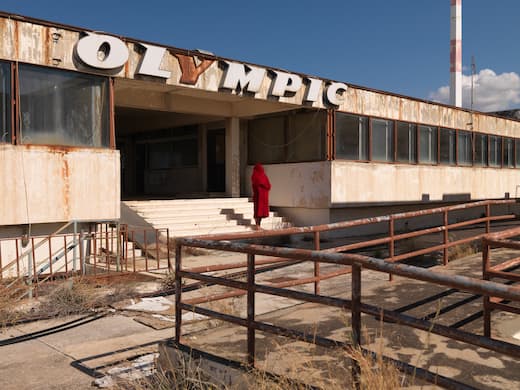Signs of New Life Amid an Ancient Greek Airport’s Beautiful Ruins
The fundamental weirdness of an airport multiplies exponentially when you take away the airplanes.

What strange creatures are airports: The more monstrous and overgrown they come, the better the odds your modern life will intertwine with theirs, if only for a hurried and angst-ridden rendezvous.
From the beastly sprawl of today’s Heathrow to the Brutalist monstrosity of Charles de Gaulle’s Terminal One, these places are stern reminders that mankind’s primary residence is on the ground and not in the sky.
The fundamental weirdness of an airport multiplies exponentially when you take away the airplanes: I’m talking about zombie airports, one whisker away from the wrecking ball because something bigger and ostensibly better is coming along. Or maybe it was a war that spelled the end, as in the case of Nicosia International Airport on the divided island of Cyprus. There, departure lounges are crumbling and ghost planes have been waiting for takeoff since 1974.
Another zombie airport is Athens’s storied Ellinikon, near the upscale suburb of Glyfada. It was not only the home of former Greek flag carrier Olympic Airways but also for many years an operations base for the U.S. Air Force.
Its vast East Terminal was designed in 1968 by Eero Saarinen, the Finnish modernist architect who made his mark at JFK with the iconic TWA terminal. Ellinikon has languished since a newer Athens airport opened inland in 2001, leaving an entire Olympic 747 to disintegrate on the tarmac and Saarinen’s terminal structure in a spectacular state of disrepair.
Not for much longer, though. The site, which straddles the Mediterranean Sea, is slated for a reboot to the tune of a reported $9 billion and that will include a high-rise luxury residence tower, hotels, shopping centers, and a showcase casino. An American company, Hard Rock, is said to be involved in steering it through.
The East Terminal and a few other buildings are Greek national heritage sites and not slated for demolition, but some 450 others at Ellinikon will be razed. We shall see whether this construction fest will raise or cheapen the cultural profile of the birthplace of democracy. In the meantime, some are finding beauty in the expired airport’s accelerating decay.
Enter Greek artist Dionisis Christofilogiannis, who along with co-curator Ariana Kalliga spearheaded Momafad, the “Museum of Modern Art for A Day” project that pretty much did what its name says: reclaimed spaces and transformed them into pop-up museums, bringing together the works of a group of contemporary artists that were then handed over to the project’s organizers for 24 hours. Momafad’s first edition took place in the course of a single day in October 2020 in Saarinen’s abandoned East Terminal and was formally inaugurated on November 18 with the presentation of a documentary film at the National Museum of Contemporary Art in Athens. According to Mr. Christofilogiannis, “both the architectural value of the building and its emotional salience as a site of public memory contributed to its selection.” In other words, the Acropolis was already taken.
Cultural jests aside, the notion of a modern art museum with a deserted airport for a stage does have considerable resonance, particularly during a pandemic when airports could be said to represent freedom and fear in equal and alternating measure. Not that the 26 installations necessarily drew on travel themes; displacement might be a more apt term, or simply subtle provocation.
On that sunny fall day, there was Yannis Adoniou’s frenzied choreography of three women in front of the abandoned terminal, and elsewhere Nichomachi Karakostanoglou’s “Deposits,” a minimalist trifecta of white marble statues described in the Momafad literature as “part architecture, part rejected objects, the three deposits here were ‘excavated’ and placed on the protective shells that transported them in the former security checkpoint area of the Ellinikon airport.”
I mention the pandemic because prior to it some airports were on the way to becoming quasi-gallery spaces; Urs Fischer’s hulking yellow “Lamp Bear” holding court after passport control at Doha’s Hamad International comes to mind. No one wants to linger much in an airport, though, and that’s what makes a happening like Momafad so prescient and so eerily perfect. The temporary installations were subsequently photographed, turning them into a permanent piece of Ellinikon’s history that one can peruse at will in book form — long after the haunted spaces that gave them life, and launched so many forgotten journeys past, are gone for good.

